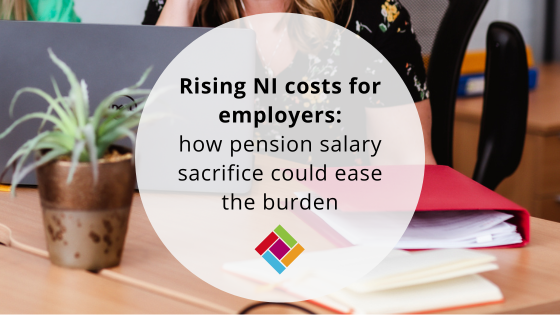
Many employers are concerned about the impending increase in the employer national insurance (NI) rate from April 2025. As announced in the Autumn Budget, this is increasing from 13.8% to 15% alongside a reduction in the secondary threshold (the income level at which employers start paying NI) from £9,100 to £5,000. In addition to increases in the National Minimum Wage, many businesses are urgently focusing on cost-saving strategies. However, one immediate way businesses can reduce their employer NIC is by taking advantage of pension salary sacrifice benefits.
How salary sacrifice can reduce NIC
Offering employee benefits via a salary sacrifice scheme creates the opportunity to reduce Employer NIC. This means the employee gives up a proportion of gross salary to receive the benefit, leading to a reduction in employer and employee NIC liability from the lower salary.
Pension salary sacrifice
This is the most beneficial form for both employer and employee. Here’s how it works:
- The employee agrees to reduce their salary by the amount they would have usually contributed (typically 5%).
- The employer increases their pension contribution by the same amount. The total pension contribution therefore stays the same.
- The salary is now reduced, so the employer and employee save on NI.
For example, an employee earning £30,000 and contributing 5% of their qualifying earnings (£1,188) into their pension under the standard auto-enrolment method currently pays this from their post-tax salary. By switching to salary sacrifice, the employee reduces their taxable salary to £28,812, saving £95 per year in NI contributions. More importantly for businesses, the employer also saves £178 per employee due to the new 15% NI rate, reducing payroll costs without affecting employees’ take-home pay. With multiple employees enrolled, these savings can quickly add up, making salary sacrifice a valuable tool for cutting costs while maintaining competitive benefits.
Key differences between salary sacrifice pensions and standard auto-enrolment pensions:
| Feature | Salary sacrifice pension | Standard auto-enrolment pension |
| How contributions are made | The employee gives up part of their salary, and the employer contributes this amount directly to the pension. | An employee contributes a percentage of their salary, deducted after tax, and the employer adds their contribution. |
| Tax & NI savings for the employee | The employee pays less National Insurance (NI) as their salary is reduced. | Pays NI on full salary. |
| Tax & NI savings for the employer | The employer saves on NI and may keep the saving or pass some savings to the employee’s pension. | The employer pays full NI on the salary. |
| Flexibility | This typically needs a formal agreement, and it can require adjustments to meet salary changes. | It’s more flexible – employees can change contribution levels more easily. |
| Impact on pay | It reduces the gross salary, which may affect mortgage applications and statutory benefits. | The salary remains the same, so there is no impact on benefits based on gross pay. |
Which one is better?
- Salary sacrifice is usually more tax-efficient, but it can have small drawbacks (e.g. impact on benefits).
- Standard auto-enrolment is simpler and more flexible, but employees miss out on the extra NI savings.
There are other benefits that can generate also NIC savings which are:
- Electric vehicle leasing.
- Cycle to work schemes.
- Additional holiday purchasing.
- Private medical.
Considerations for employees
In addition to saving on NI, there are other advantages for employees to sacrifice larger amounts to reduce their salary, such as fitting into a lower tax band or meeting child benefit entitlements. It could also encourage more people to save for retirement. However, a pension salary scheme should not take an employee’s pay below the national minimum or living wage thresholds. Employees should also consider that benefits dependent on the gross pay will be affected by salary sacrifice, including statutory calculations (such as Statutory Maternity Pay). Mortgage lenders also look at gross salary when lending, so employees will need to weigh up the options and decide what’s right for their personal circumstances.
Next steps
- Review your existing benefits:
- Do they meet your workforce’s needs?
- Are there any gaps?
- Consider the support you will need to get to the ideal benefits offering landscape for staff.
- Review feasibility and legal compliance:
- Assess whether salary sacrifice is suitable for your workforce (i.e. if it will take them below the national minimum wage).
- Ensure that the pension scheme rules allow salary sacrifice contributions.
- Ensure compliance with HMRC guidelines in line with employment law.
- Consult with employees:
- Communicate the changes, highlighting the benefits and negatives.
- Supply written details to employees (such as FAQs and guidance documents).
- Meet with staff to address any potential concerns.
- Draft an employer agreement
- Employees must opt in voluntarily and sign a new agreement as salary sacrifice is a contractual change.
- Make payroll adjustments
- Update payroll systems to reflect the reduced salaries and new contributions.
- Ensure National Insurance savings are accounted for.
- Review
- Regularly review the scheme to make sure it stays beneficial for both employees and employers.
- Allow employees to opt-out if their circumstances change.
- Stay up to date with legislative changes which could affect salary sacrifice schemes.
These steps could offer businesses the vital route they need to mitigate the impact the rises will have. Not forgetting the potential benefits, they could bring to employees. If you would like to advise on reviewing your benefits and introducing a salary sacrifice scheme, get in touch for a free advisory call so we can tell you more. Did you know that we can also manage your payroll for you?